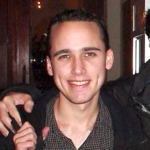Top 10 of the world’s most famous hackers
[lgc_column grid=”100″ tablet_grid=”100″ mobile_grid=”100″ last=”false”]
1. John Draper
 John Thomas Draper (born March 11, 1943), also known as Captain Crunch. This phreaker (“Pirate’s phone”) whose real name is John Thomas Draper (born March 11, 1943) became famous because he managed to make free long distance calls with a whistle found in Cap’n Crunch cereal box. Indeed, the sound from this whistle had a frequency of 2600 Hertz, the same frequency as a long-distance line unoccupied continuously emitted to indicate to a telephone exchange is ready to receive a call. The phreaked called a remote toll opening an unused line that did not record billing.
John Thomas Draper (born March 11, 1943), also known as Captain Crunch. This phreaker (“Pirate’s phone”) whose real name is John Thomas Draper (born March 11, 1943) became famous because he managed to make free long distance calls with a whistle found in Cap’n Crunch cereal box. Indeed, the sound from this whistle had a frequency of 2600 Hertz, the same frequency as a long-distance line unoccupied continuously emitted to indicate to a telephone exchange is ready to receive a call. The phreaked called a remote toll opening an unused line that did not record billing.
[/lgc_column]
[lgc_column grid=”100″ tablet_grid=”100″ mobile_grid=”100″ last=”false”]
2. Steve Jobs and Steve Wozniak
 Both have several things in common, the two famous founders of Apple Computer have spent their youth as hackers. Before moving to Apple, they spent their days building called Blue Box devices that allowed for the whistle as John Draper to make long distance calls without paying a dime. They then started selling these devices to their classmates at the University of California.
Both have several things in common, the two famous founders of Apple Computer have spent their youth as hackers. Before moving to Apple, they spent their days building called Blue Box devices that allowed for the whistle as John Draper to make long distance calls without paying a dime. They then started selling these devices to their classmates at the University of California.
We could add Mark Zuckerberg (founder of Facebook), Bill Gates (Microsoft founder), Linux Torvalds (Linux kernel founder) who have all some relations with hacking.
[/lgc_column]
[lgc_column grid=”100″ tablet_grid=”100″ mobile_grid=”100″ last=”false”]
3. David Smith
 All the popularity of David Smith came after creation of the worm “Melissa” on 26 March 1999. The Worm was saturated messaging systems by spreading user to user via infected emails (there are over 60 000). Damage estimates were $385 million. Smith, who was arrested, sentenced to 2 years in prison and $5000 fine sad the worm was never intended to cause damage.
All the popularity of David Smith came after creation of the worm “Melissa” on 26 March 1999. The Worm was saturated messaging systems by spreading user to user via infected emails (there are over 60 000). Damage estimates were $385 million. Smith, who was arrested, sentenced to 2 years in prison and $5000 fine sad the worm was never intended to cause damage.
The first time the Melissa worm was hidden, it was in a file containing pornographic sites passwords. Smith said that the name Melissa has just met a dancer during a trip to Florida.
[/lgc_column]
[lgc_column grid=”100″ tablet_grid=”100″ mobile_grid=”100″ last=”false”]
4. George Hotz alias GeoHot
 George Hotz is an American hacker known for unlocking the iPhone (the famous jailbreak) and its release the Playstation 3. The jailbreak of making jump the protections of devices running the iOS operating system, providing access to all the features of it, and making it possible to download and install applications without paying.
George Hotz is an American hacker known for unlocking the iPhone (the famous jailbreak) and its release the Playstation 3. The jailbreak of making jump the protections of devices running the iOS operating system, providing access to all the features of it, and making it possible to download and install applications without paying.
When Sony was attacked, allegedly by the group Anonymous, Hotz said he was not reponsible for the attack.
[/lgc_column]
[lgc_column grid=”100″ tablet_grid=”100″ mobile_grid=”100″ last=”false”]
5. Michael Calce alias MafiaBoy
 Mafiaboy is a Canadian who has acquired a certain notoriety after launching in February 2000 a series of DDoS attacks against several web sites such business giants as eBay, Amazon, Yahoo!, Dell or CNN.
Mafiaboy is a Canadian who has acquired a certain notoriety after launching in February 2000 a series of DDoS attacks against several web sites such business giants as eBay, Amazon, Yahoo!, Dell or CNN.
He was only 15 years old then, and now says he was not professional, far from it, he used the programs that his friends had done. Calce operated websites mainly for fame and to show his dominance in his group. He now works for a computer security company.
[/lgc_column]
[lgc_column grid=”100″ tablet_grid=”100″ mobile_grid=”100″ last=”false”]
6. Gary McKinnon
 In 2002, a special message appears on the screen of a computer of the US Army: “Your security is the sh*t, I am Solo and I will continue to disrupt at the highest levels.”
In 2002, a special message appears on the screen of a computer of the US Army: “Your security is the sh*t, I am Solo and I will continue to disrupt at the highest levels.”
It was later learned that this is a message from a British systems administrator named Gary McKinnon. McKinnon allegedly accessed 97 computers belonging to the US Army, NASA, the Army, the Air Force, the Navy, the Ministry of Defense and the Pentagon.
Gary explains that he wanted to do all this to find out once and for all if there were UFOs and thought the US had recovered an alien anti-gravity technology. Then he risked 70 years in prison, Gary was diagnosed as suffering from a form of autism and will not be extradited to the United States where he faced a big trouble. [/lgc_column]
[lgc_column grid=”100″ tablet_grid=”100″ mobile_grid=”100″ last=”false”]
7. Robert Tappan Morris
 In 1988, the graduate student from Harvard University decided to test the size of the Internet. He created the Morris worm that infect 6000 Unix machines by making it crash. Millions of dollars of damage will then be estimated. It was probably the first worm of this kind. Morris was finally captured, fined, sentenced to three years probation and 400 hours of community service.
In 1988, the graduate student from Harvard University decided to test the size of the Internet. He created the Morris worm that infect 6000 Unix machines by making it crash. Millions of dollars of damage will then be estimated. It was probably the first worm of this kind. Morris was finally captured, fined, sentenced to three years probation and 400 hours of community service.
The disk used to write the worm is now available in Boston science museum. And Morris is now a professor at the Massachusetts Institute of Technology.
[/lgc_column]
[lgc_column grid=”100″ tablet_grid=”100″ mobile_grid=”100″ last=”false”]
8. Adrian Limo
 In December 2001, Lamo was praised by Worldcom for helping to fortify their corporate security. In February 2002, he broke into the internal computer network of The New York Times, added his name to the internal database of expert sources, and used the paper’s LexisNexis account to conduct research on high-profile subjects. The New York Times filed a complaint, and a warrant for Lamo’s arrest was issued in August 2003 following a 15-month investigation by federal prosecutors in New York. At 10:15 AM on September 9, after spending a few days in hiding, he surrendered to the US Marshals in Sacramento, California. He re-surrendered to the FBI in New York City on September 11, and pleaded guilty to one felony count of computer crimes against Microsoft, LexisNexis, and The New York Times on January 8, 2004.
In December 2001, Lamo was praised by Worldcom for helping to fortify their corporate security. In February 2002, he broke into the internal computer network of The New York Times, added his name to the internal database of expert sources, and used the paper’s LexisNexis account to conduct research on high-profile subjects. The New York Times filed a complaint, and a warrant for Lamo’s arrest was issued in August 2003 following a 15-month investigation by federal prosecutors in New York. At 10:15 AM on September 9, after spending a few days in hiding, he surrendered to the US Marshals in Sacramento, California. He re-surrendered to the FBI in New York City on September 11, and pleaded guilty to one felony count of computer crimes against Microsoft, LexisNexis, and The New York Times on January 8, 2004.
In February 2009, a partial list of the anonymous donors to the WikiLeaks not-for-profit website was leaked and published on the WikiLeaks website. Some media sources indicated at the time that Lamo was among the donors on the list.
[/lgc_column]
[lgc_column grid=”100″ tablet_grid=”100″ mobile_grid=”100″ last=”false”]
9. Kevin Poulsen
 The black hat hacker in the 80s, Kevin Poulsen, became popular when he “earned” a Porsche by hacking a radio station. A radio station in Los Angeles (KMS-FM) launched a radio contest in which the 102nd caller wins a Porsche. Kevin, along with two friends entered the radio telephone system to make sure to be the 102nd caller and win the prize.
The black hat hacker in the 80s, Kevin Poulsen, became popular when he “earned” a Porsche by hacking a radio station. A radio station in Los Angeles (KMS-FM) launched a radio contest in which the 102nd caller wins a Porsche. Kevin, along with two friends entered the radio telephone system to make sure to be the 102nd caller and win the prize.
He plead guilty and was sentenced to 4 years and 3 months in prison, the longest sentence ever imposed at the time. After leaving prison, Kevin is now working as a journalist for Wired News.
[/lgc_column]
[lgc_column grid=”100″ tablet_grid=”100″ mobile_grid=”100″ last=”false”]
10. Kevin Mitnick
 At age 13, Mitnick used social engineering and dumpster diving to bypass the punch card system used in the Los Angeles bus system. After he convinced a bus driver to tell him where he could buy his own ticket punch for “a school project”, he was able to ride any bus in the greater LA area using unused transfer slips he found in a dumpster next to the bus company garage. Social engineering later became his primary method of obtaining information, including user-names and passwords and modem phone numbers.
At age 13, Mitnick used social engineering and dumpster diving to bypass the punch card system used in the Los Angeles bus system. After he convinced a bus driver to tell him where he could buy his own ticket punch for “a school project”, he was able to ride any bus in the greater LA area using unused transfer slips he found in a dumpster next to the bus company garage. Social engineering later became his primary method of obtaining information, including user-names and passwords and modem phone numbers.
Mitnick first gained unauthorized access to a computer network in 1979, at 16, when a friend gave him the phone number for the Ark, the computer system Digital Equipment Corporation (DEC) used for developing their RSTS/E operating system software. He broke into DEC’s computer network and copied their software, a crime he was charged with and convicted of in 1988. He was sentenced to 12 months in prison followed by three years of supervised release. Near the end of his supervised release, Mitnick hacked into Pacific Bell voice mail computers. After a warrant was issued for his arrest, Mitnick fled, becoming a fugitive for two and a half years.
According to the U.S. Department of Justice, Mitnick gained unauthorized access to dozens of computer networks while he was a fugitive. He used cloned cellular phones to hide his location and, among other things, copied valuable proprietary software from some of the country’s largest cellular telephone and computer companies. Mitnick also intercepted and stole computer passwords, altered computer networks, and broke into and read private e-mails.
Since 2000, Mitnick has been a paid security consultant, public speaker and author. He does security consulting for Fortune 500 companies and the FBI, performs penetration testing services for the world’s largest companies and teaches Social Engineering classes to dozens of companies and government agencies.
[/lgc_column]

